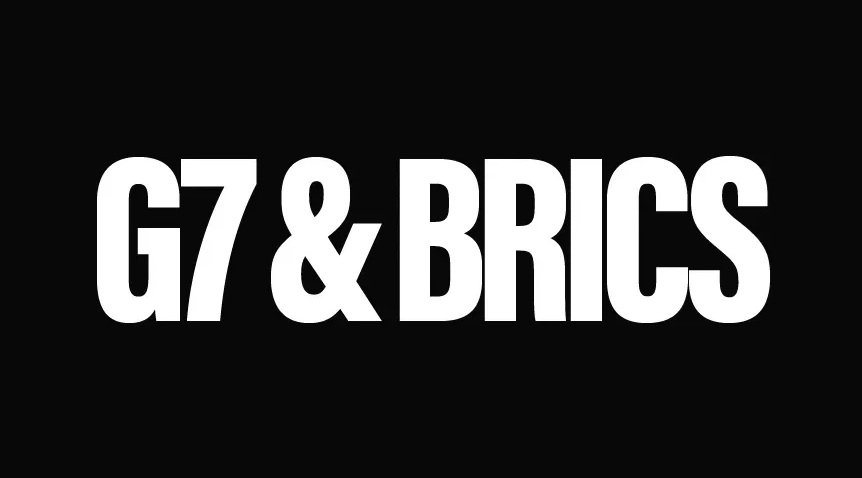Comparing BRICS and G7: A Comprehensive Analysis
The global economic and political landscape is shaped by alliances and groupings of nations with shared objectives. Two of the most influential groups are BRICS (Brazil, Russia, India, China, South Africa) and G7 (Group of Seven). Despite their common goal of influencing global policies, their composition, objectives, and impact on the world stage differ significantly. Let’s analyze these two groups in detail.
🌍 What Are BRICS and G7?
BRICS:
- An acronym for Brazil, Russia, India, China, and South Africa.
- Established to represent the interests of emerging economies.
- First formal meeting occurred in 2009 (South Africa joined in 2010).
- Focus: Economic development, trade cooperation, and reforming global governance institutions like the World Bank and IMF.
G7:
- A group of seven advanced economies: the United States, United Kingdom, Canada, France, Germany, Italy, and Japan.
- Founded in 1975 as a forum for industrialized nations to discuss global economic issues.
- Focus: Promoting democracy, economic stability, and multilateral solutions to global challenges.
🔍 Key Differences Between BRICS and G7
| Category | BRICS | G7 |
|---|---|---|
| Economic Power | Emerging economies with high growth potential. | Advanced economies with high per capita income. |
| Geopolitical Focus | Reforming global governance to reflect multipolarity. | Upholding Western liberal democratic values. |
| GDP (2023) | ~25% of global GDP (nominal terms). | ~45% of global GDP (nominal terms). |
| Population | ~3.2 billion people (~41% of the world). | ~800 million people (~10% of the world). |
| Primary Objectives | Development, inclusivity, and South-South cooperation. | Stability, security, and democratic governance. |
| Leadership | Rotational (informal group). | Western leadership, often US-dominated. |
| Institutions | New Development Bank (NDB). | No formal financial institution. |
📊 Economic Influence: A Closer Look
- GDP Growth:
- BRICS nations are expected to drive future global economic growth due to their rapidly expanding middle class and industrialization.
- G7 countries, while dominant, face slower growth rates as their economies are already highly developed.
- Trade and Investment:
- BRICS emphasizes trade among member states and reducing dependence on Western economies.
- G7 members are heavily integrated with one another and control a significant share of global trade and finance.
🔑 Geopolitical Influence
BRICS:
- Advocates for multipolarity and greater representation of developing nations in global institutions.
- Key achievements include creating the New Development Bank and advocating for the use of local currencies in trade to reduce reliance on the US dollar.
- Challenges: Internal disagreements (e.g., India-China tensions) and varying levels of economic development.
G7:
- Dominates institutions like the IMF, World Bank, and UN Security Council.
- Focuses on addressing global challenges like climate change, cybersecurity, and financial crises.
- Challenges: Perceived as a “club of the rich” and declining influence as emerging economies rise.
🌐 Global Perception and Soft Power
- BRICS: Seen as a counterbalance to Western-dominated structures. Strong appeal among developing nations but faces criticism for lacking a unified vision.
- G7: Maintains significant soft power through cultural influence, technology, and global media dominance. However, its exclusivity limits its appeal to non-members.
📈 Future Outlook: Collaboration or Competition?
- BRICS:
- Expanding membership (e.g., discussions about including countries like Indonesia or Argentina).
- Potential to reshape global trade and finance.
- Needs to address internal divisions and develop a cohesive strategy.
- G7:
- Likely to maintain dominance in technological innovation and high-value industries.
- May need to engage more with emerging economies to remain relevant.
🤔 Key Takeaways
- BRICS represents the aspirations of emerging economies, focusing on reform and inclusivity.
- G7 champions stability and the established global order.
- The two groups are not direct rivals but reflect different perspectives on global governance.
The future of global leadership may hinge on how these two alliances interact—whether through collaboration, competition, or a combination of both.







